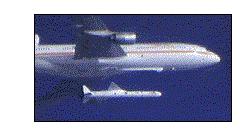
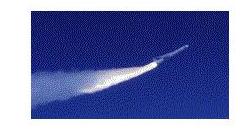
 Copyright © Michael Richmond.
This work is licensed under a Creative Commons License.
Copyright © Michael Richmond.
This work is licensed under a Creative Commons License.
The key to identifying the source of GRBs was to pin down their positions to areas much smaller than a square degree. Today, we'll look at how that was done.
BATSE can locate GRBs with poor precision: it leaves an "error circle" about 3 to 5 degrees in radius. That's much too big to allow optical and radio astronomers to look for a counterpart.
In order to locate GRBs more precisely, NASA awarded to a team led by MIT a contract to build the High Energy Transient Experiment, a satellite which could
The HETE team hoped to be able to calculate the position of a GRB to within less than an arcminute, which would decrease the area of the "error circle" by a factor of about 10,000 compared to BATSE.
The contract was awarded in 1992, and the craft was launched on a Pegasus booster on Nov 4, 1996.


Unfortunately, the third stage of the Pegasus rocket failed to release HETE and another satellite, and the mission was a failure.
The failure of HETE left the field open to a team from Europe: astronomers in Italy and the Netherlands built a satellite called BeppoSAX, which was designed to study X-ray and gamma-ray sources.
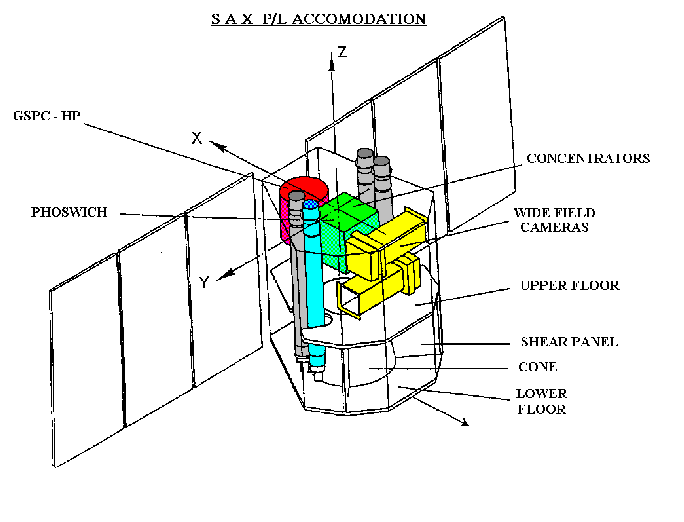
BeppoSAX, like HETE, has several instruments. The important ones for our purposes are:
Both of the instruments aboard BeppoSAX provide much smaller areas to search than BATSE:
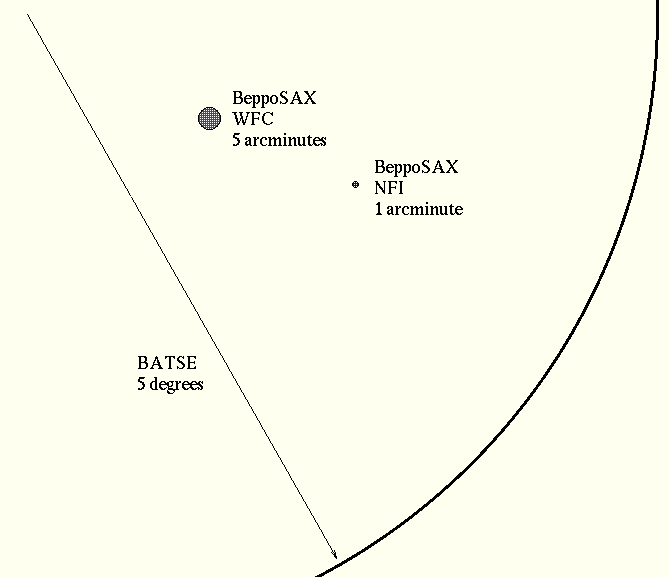
Note that the NFI point 90 degrees away from the wide-field cameras. That means that if either WFC detects a gamma ray event, the entire spacecraft must rotate by 90 degrees to bring the NFI to bear on the object. This takes more than four hours!
BeppoSAX was launched on April 30, 1996. About a year later, it made history.
On Febuary 28, 1997, the gamma-ray burst monitors on the BeppoSAX satellite detected a moderately strong burst, lasting about 80 seconds. The Wide-Field Camera also detected this event, and measured a position with an uncertainty of about 0.05 degrees. Here's the official announcement, from IAU Circular 6572:
The BeppoSAX Gamma Ray Burst Monitor (GRBM) was triggered on Feb. 28.123620 UT. A quick-look analysis of the GRBM light curve shows a moderately intense, multi-peaked gamma-ray burst lasting about 80 s, with one major structured peak followed by three minor peaks. The first peak intensity at maximum is about 3700 counts/s, while the trailing peaks show a decreasing intensity from 600 to 150 counts/s. The gamma-ray burst was detected by the Wide Field Camera (WFC) number 1 with a similar time profile and a peak countrate of about 400 counts/s. Taking into account the off-axis position, the peak flux corresponds to about 0.23 Crab. From the WFC image, we have derived a preliminary position of R.A. = 5h01m57s, Decl. = +11 46'.4 (equinox 2000.0), with a 3' error radius. A BeppoSAX TOO pointing of the Narrow Field Instruments was performed starting on Feb. 28.458, just 8 hr after the GRB trigger time.
Within hours, the spacecraft operators rotated BeppoSAX so that its NFI could observe the area. They detected X-rays coming from the same spot on the sky -- where no X-ray source had been seen before. The NFI narrowed down the position to about one arcminute, or about 0.015 degrees. The X-ray emission from this source decreased swiftly over the next few days:
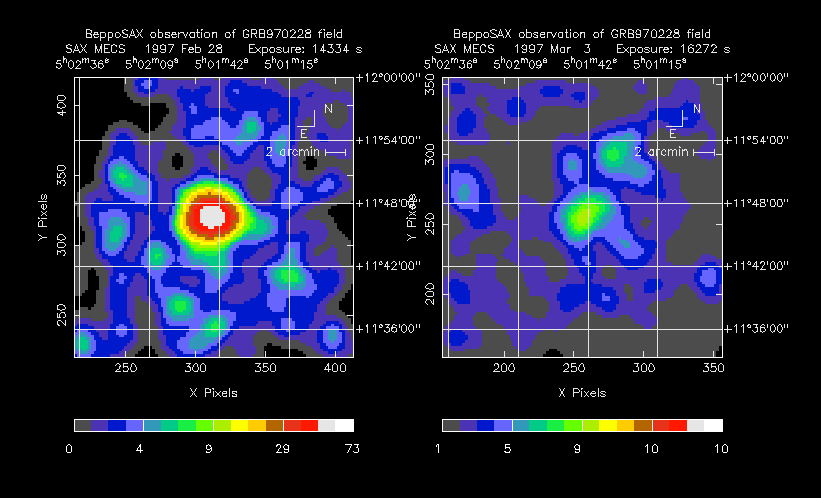
Aha! Given such a uncertainty in position, optical and radio astronomers had a decent chance of finding a counterpart; the entire error circle would fit within a single field of view of typical big telescopes. A team of European astronomers led by Jan van Paradijs used the 4.2-m telescope on the Canary Islands to take pictures of the spot. There were many little fuzzy sources within the error circle, so they weren't sure which one -- if any -- was associated with the GRB. But when they looked again, eight days later, they found that one of the sources had become much fainter -- just like the X-ray source.

The transient source appeared in near-infrared images taken on March 17, about two and a half weeks after the burst. This is a false-color image -- red simply means "bright" and blue "faint". The GRB counterpart appears at the center of the area outlined in black ...
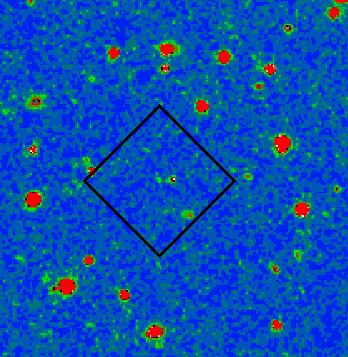
The Hubble Space Telescope took a picture on March 26, 1997, about 4 weeks after the gamma ray burst. It was able to see a very faint optical source at the burst position (this image corresponds to the area outlined in black in the IR image above).
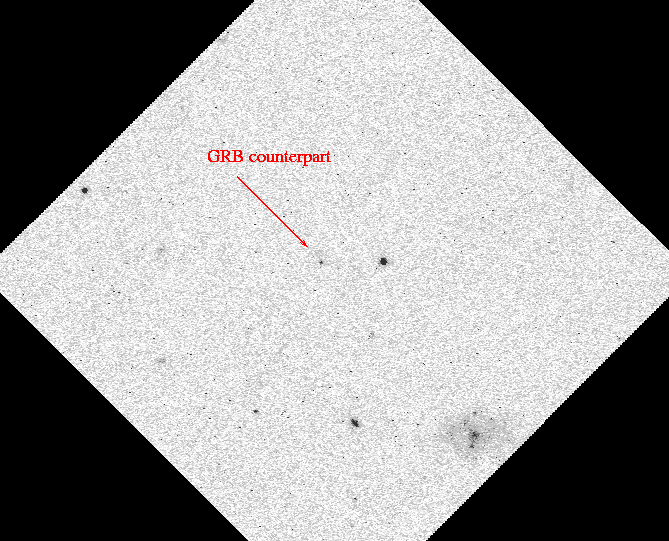
A closeup view of the source in the HST image reveals that it is a bright point source superimposed on a much fainter, slightly extended object -- perhaps a galaxy?
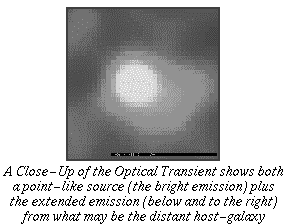
The source faded in an exponential manner over a period of several months:
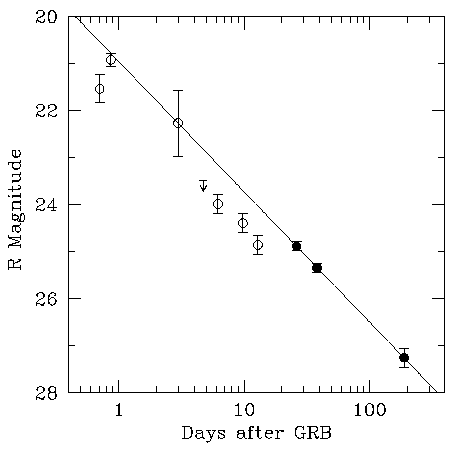
This gave us some clues about the nature of the event. Unfortunately, it was too faint to provide a useful spectrum. So, there was a hint that the GRB may have occurred very far away, in a galaxy so distant that it appears as a tiny smudge ... but we still weren't sure.
The next big break came when BeppoSAX detected a GRB on May 5, 1997 (which was given the name "GRB 970508"). Once again, BeppoSAX was able to provide a precise position about 8 hours after the burst occurred. Many astronomers turned their telescopes to the tiny error circle, and a number found a new optical source.
Images taken very soon after the burst showed a faint source (this image is about 3 arcminutes on a side)
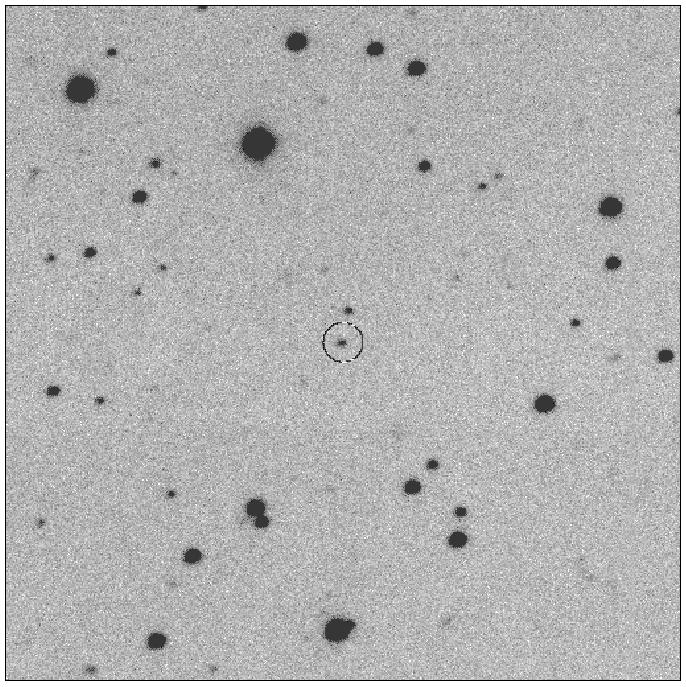
which, strangely enough, became brighter over the next 24 hours:
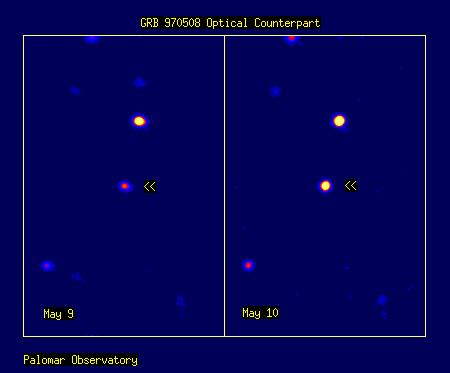
In this case (but in very few other GRB counterparts discovered since), even though the gamma-ray and X-ray emission decreased quickly, the optical light increased gradually and reached a peak about a day after the gamma-ray burst.
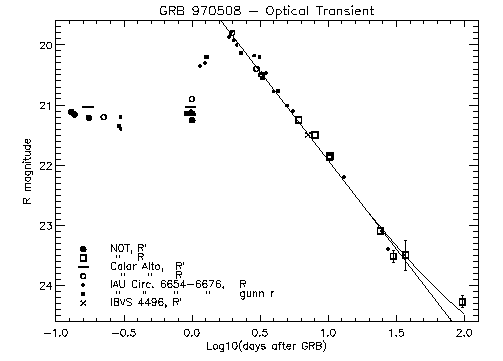
But the most exciting thing was that one group of astronomers was able to take a spectrum of the object with the Keck II telescope on May 11.
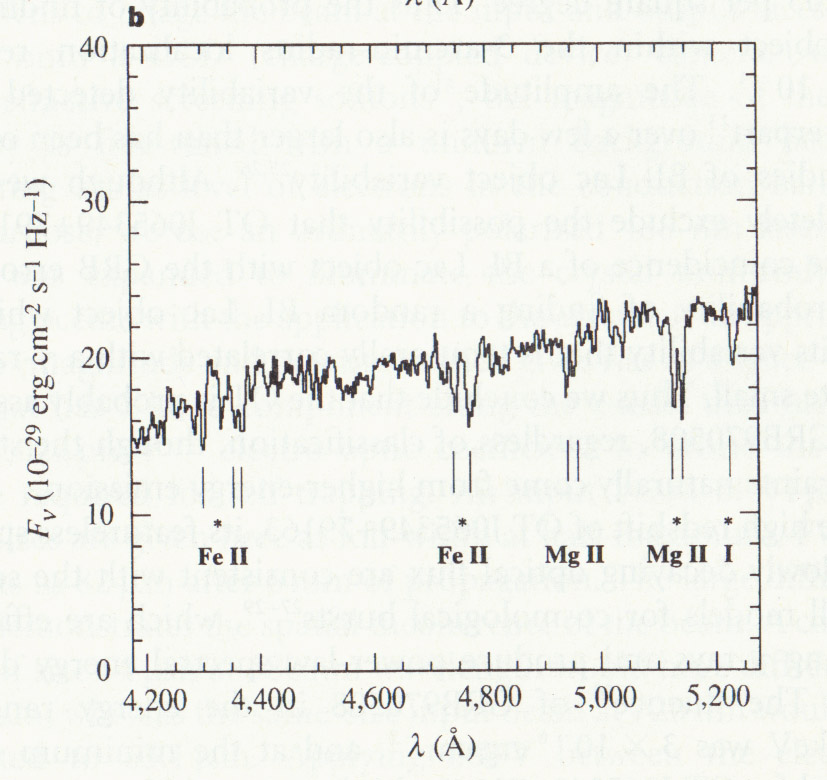
Here's what they wrote, in IAUC 6655:
Metzger, Djorgovski, C. C. Steidel (CIT), Kulkarni, K. L. Adelberger (CIT), and Frail further write: "Spectra of Bond's variable were obtained using the Keck II 10-m telescope (+ LRIS) on May 11.25 UT. The object has no obvious emission lines. We have identified a set of aborption features between 430 and 514 nm that we associate with the Fe II triplet near 237.5 nm, Fe II at 258.6 and 260.2 nm, and Mg II at 279.6 and 280.3 nm, which places this system at z = 0.835. Several other absorption features are also seen. If the source is associated with GRB 970508, it is evident that the gamma-ray burst lies at z >/= 0.835. Absence of prominent Lyman-alpha forest in the spectrum also suggest that the source is at redshift z < 2.1."
These absorption lines in the spectrum of the GRB counterpart mean that the GRB itself must be behind the absorbing material; it must be further away than the galaxy which is absorbing its light. That galaxy is very, very distant: a redshift of 0.835 corresponds to many hundreds of Mpc. Therefore, this GRB -- and, by extension, all GRBs, probably -- is "cosmological": located in the far reaches of the universe, far beyond our own galaxy or Local Group.
A set of pictures taken by the Hubble Space Telescope a year apart show that the optical counterpart appears superimposed on a very faint galaxy.
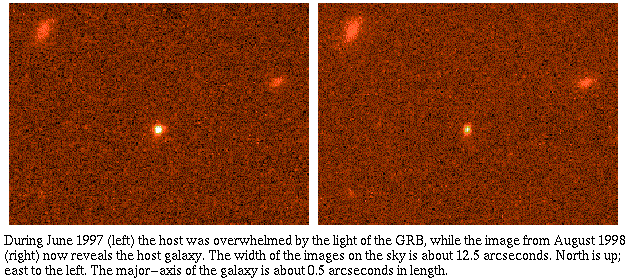
This faint galaxy is probably the host of the GRB, rather than the intervening absorber. The two galaxies in the upper corners of this image are about 5 arcseconds away from the GRB, to the North-East (upper left) and West-North-West (upper right); one of them may be the absorber.
Back in the 1980s, there was a brief flurry of excitement over the possibility that amateur astronomers might have captured optical counterparts to GRBs in "star trail" pictures. Such flashes would have been much, much, brighter than the optical counterparts discovered in 1997. Was it possible for optical flashes to be so bright?
As electronic detectors and computers became ever cheaper, several teams of astronomers came to realize that it was possible to build wide-angle camera systems which
One of these groups called itself the Robotic Optical Transient Search Experiment or ROTSE for short. They assembled four CCD cameras behind 200-mm telephoto lenses, and mounted them all together:
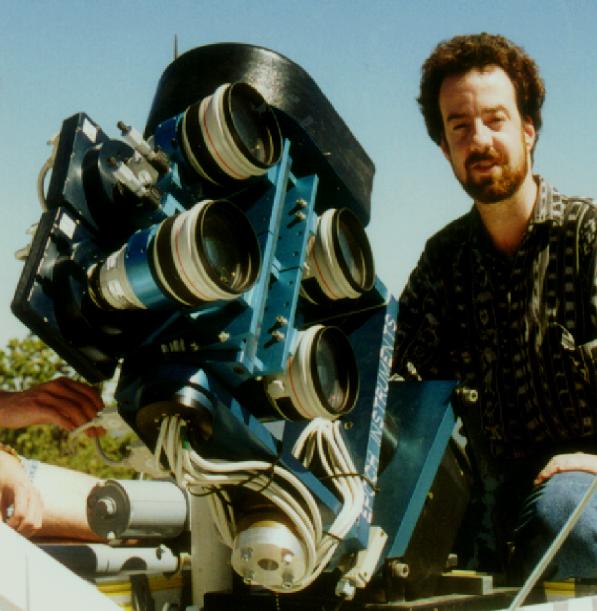
This system covered an area on the sky 16 degrees on a side -- large enough to contain the entire error circle from BATSE, with lots of room to spare. The ROTSE computers listened carefully for "fast alert" signals from BATSE, so that they could quickly steer the cameras to the general direction from which a burst originated.
On Jan 23, 1999, BATSE detected a burst of gamma rays, starting at 9:46:59, UT. Within 23 seconds, the ROTSE system had slewed to the proper position and started taking pictures. Here's what it found; the top three exposures are 5 seconds long each, followed by three exposures of 75 seconds:
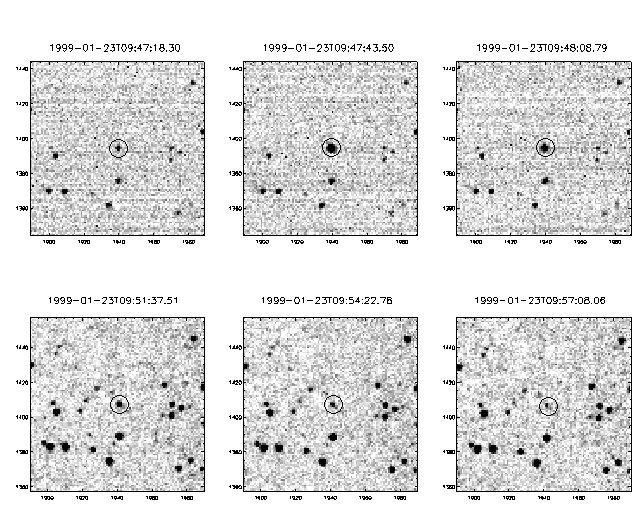
An optical source appears in the first picture, brightens in the second, then rapidly fades away. Estimates of its magnitude are
mag 11.82, 8.95, 10.08, 13.22, 14.00, 14.53Wow! Magnitude 8.95 is bright enough to be seen with binoculars! All previous optical counterparts had been closer to magnitude 20, which requires a big telescope, electronic detector and long exposures. This GRB's counterpart was about 10,000 times brighter than the others.
Why is this important? Many theorists had devised models for the events which produce GRBs, and those models were designed to yield relatively small amount of energy in the visible range. But this detection meant that, in one case at least, a GRB also produced huge amounts of energy in the optical.
So, just what causes gamma ray bursts? There have been hundreds of models put forth over the years, but as we have discovered more and more about the events, most of the models have proven wrong. Let's make a list of the features a theory must explain:
k
optical intensity = (time)
So, put it all together, and what do you get? A star-sized object which suddenly gives rise to relativistic particles and millions of times more energy than an entire galaxy of stars. Hmmmm....
The energy criterion is a tough one. It's hard to create that much energy. If one took all the hydrogen in the Sun, and -- all at once -- fused it together into helium, the result would be the release of about 10^(52) ergs of energy. That's still 10 times less than some GRBs appear to emit. Where can it come from?
A lot of it probably comes from gravitational potential energy. If you hold a ball six feet above the ground, then let it go, it falls downward, turning gravitational potential energy into kinetic energy. Any material which is held up high in a gravitational field has this kind of potential energy. That includes stars: the material in their outer layers is hundreds of thousands of kilometers "above" their core. If that material collapsed inwards, it would acquire very large amounts of kinetic energy. The gravitational potential energy stored in the middle and outer layers of our Sun is around 10^(54) ergs, considerably more than the energy which can be released by thermonuclear reactions. This amount of energy is close to the amount of energy which is emitted by GRBs. Coincidence?
One way to decrease the energy emitted by GRBs is to postulate that the radiation is beamed:
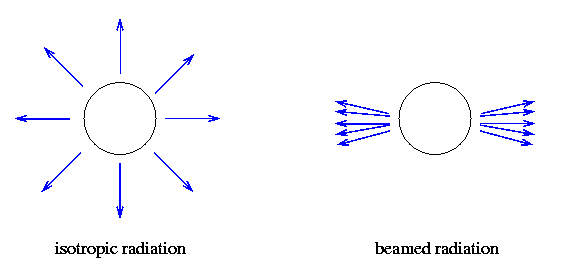
If energy is emitted only in a small cone, rather than isotropically, then
The current models of GRBs all involve a few common features:
But the theorists are still hard at work, devising new features and working to explain the latest observations. When I went to the Los Alamos astrophysics preprint server on Sunday, April 9, 2000, and searched the archive for papers submitted in the past year with the words gamma ray burst model in the Abstract, I found 113 papers!
Update: On Jan 5, 2001, a search for gamma ray burst model on astro-ph found 89 papers published in the past year.
After the failure of HETE in 1996, the HETE team realized that they could build another satellite for very little extra money, using the spare parts from their first effort. They also used information we learned about GRBs in the past few years to improve the choice of detectors: they dropped the UV cameras in favor of low-energy X-ray cameras.
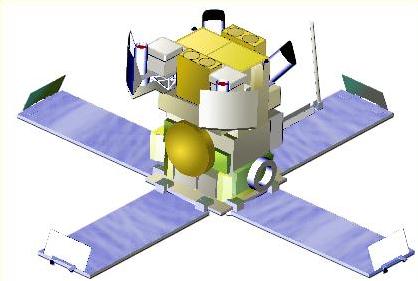
The HETE-2 spacecraft features:
The instruments aboard HETE-2 will cover a fairly large area on the sky, about 70 degrees on a side:
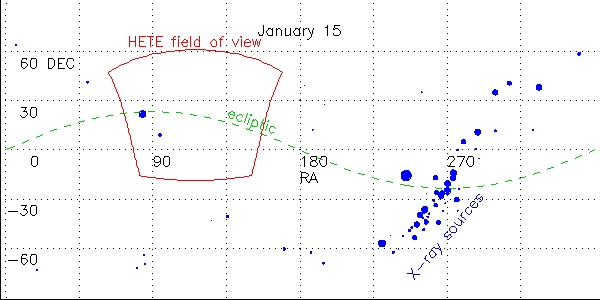
The big advantage of HETE-2 over Beppo-SAX is that all the instruments look in the same general area of the sky simultaneously, so HETE-2 will be able to provide precise positions for GRBs much more quickly than Beppo-SAX.
HETE-2 was successfully launched on Oct 9, 2000. It is currently orbiting the Earth and detecting gamma-ray events. You can check its status by visiting
For more information, see
 Copyright © Michael Richmond.
This work is licensed under a Creative Commons License.
Copyright © Michael Richmond.
This work is licensed under a Creative Commons License.